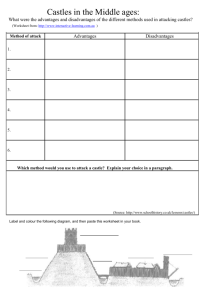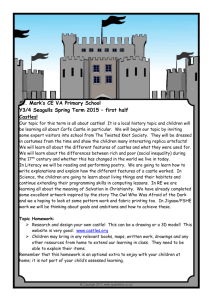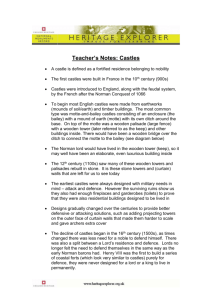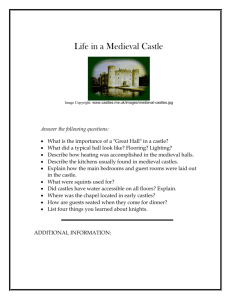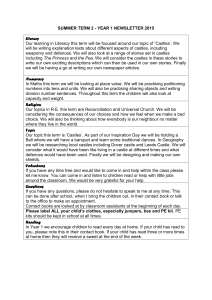File - Ossett History
advertisement
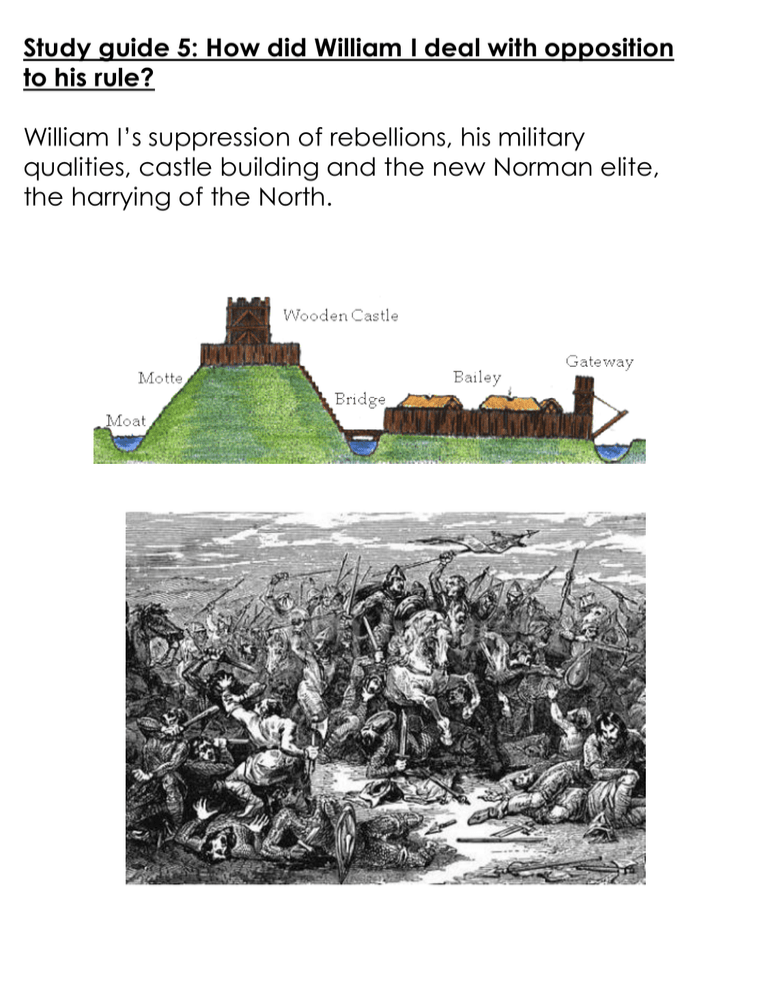
Study guide 5: How did William I deal with opposition to his rule? William I’s suppression of rebellions, his military qualities, castle building and the new Norman elite, the harrying of the North. Introduction William had won a decisive victory at Hastings, but he had not gained full control of the kingdom yet. Archbishop Stigand immediately put Edgar Aelthing , Edward the Confessor’s great nephew, forward as the new king. However, William’s brutal march through Kent, Berkshire and Winchester in October and November isolated London and the remaining figures of Harold’s regime: Edwin , Morcar, Edgar Aethling and his sister, Edith, all surrendered to William, who was duly crowned on Christmas Day 1066 with all the full coronation rites of an Anglo Saxon king. William felt confident enough to return in triumph to Normandy early 1067 with the leading Anglo Saxons in his train, and booty plundered from the churches and halls of England. But from 1067 to 1071 a series of revolts across England posed a great threat to his fragile government. He put them down with great brutality; any pretence he had to being the legitimate heir of Edward the Confessor was ended in this period. To underpin his occupation he built hundreds of castles across the kingdom, garrisoned by armed, mounted troops. Only after 1075, after a rebellion by his own earls , was the first phase of the conquest complete, and by this time England was under virtual military law. How did William deal with rebellion? In 1067 William left England under the care of two of his most trusted lords: his cousin William fitzOsbern and his half brother, Odo, Bishop od Bayeux. The period of peace was short lived. Rebellions broke out all across England: William subdued them with brutal , forceful and decisive action. The Welsh border 1067 Later in the year, Edric ‘the Wild’ raised a revolt in Herefordshire along the Welsh border , encouraging Welsh princes to join him. The failed to take control of the border and retired to Wales with much booty. The south west( 1068) William returned to England late 1067 to face more serious threats in the south west. In 1068, the city of Exeter refused to accept William’s rule but eventually did so after an 18 day siege. William built a castle and made a Norman, Baldwin, the guardian of the castle in Exeter. William also installed his other half brother , Robert of Mortain, an earl of Cornwall, and submitted Bristol and Gloucester to his rule on the way back. During the summer of 1068 the sons of Harold Godwinsson landed on the Somerset coast but were repelled by the English troops. William celebrated Easter at Winchester, and soon afterwards his wife Matilda was crowned queen at Westminster , where the king held a great court. William ended the year 1068 with a series of lightening rides through Warwick, Nottingham , York, Lincoln, Huntingdon and Cambridge to show his presence as the new king. The north ( 1069-1070) Despite the efforts of William, the remaining Anglos Saxon leaders, earls Edwin and Morcar and Edgar Atheling defected from William's court and sought support from the north in 1068. The north was still semi independent of the south. Northern earls had not interfered to save Godwin in 1051 or help Edward in 1052 and had thrown out Tostig in 1065. Their political and ethnic separatism was potentially very dangerous to William’s fragile hold on power at this stage. William marched north to deal with this threat, establishing castles on his way, in particular a castle at Warwick (in Mercia) seemed to have cut Edwin and Morcar off from the north and compelled them to resubmit to William. When William reached York the rebels fled, including their leaders Edgar the Aetheling and Gospatric earl of Northumbria who went to Scotland. In January 1069 rebels burned to death the new Norman Earl of Northumbria Robert of Commines in the bishop's house in Durham. The insurrection spread to York , where the Norman garrison came under attack. Gospatric and Edgar the Aetheling quickly joined the rebellion in York. William stormed north and relieved the garrison, the rebels melted away once more, rather than face pitched battle. In 1069, at the request of Edgar the Aetheling a Viking army of 240 ships , led by the brother and sons of Danish King Swegn Estrithsson, landed at the Humber and marched on York. Swegn was the nephew of Canute and Earl Godwin and had been king of Denmark since 1047. After their landing , Swegn’s sons found much support amongst the native Anglo Scandinavians in the east of England as well as the English including Edgar Atheling. They seized York and their success probably encouraged revolts in Dorset, Somerset, Staffordshire and Cheshire. Furthermore, the king of Scotland, Malcolm Canmore, raided into Northern England, further adding to the mounting crisis facing William. William now faced the possibility of a Scandinavian kingdom in northern England or a separated kingdom created for Edgar, the last prince of the royal house of Wessex. The ‘Harrying of the North’ William reacted with characteristic vigour, skill and utter brutality. He marched north with seasoned troops from Nottingham to York, devastating the countryside as he went and slaughtering all male adults. He burned York and after Christmas , set about a systematic destruction of Yorkshire. What his troops inflicted on the people was so terrible that chroniclers remembered it over 50 years later. Corpses rotted on the roads, refugees fled in terror , disease and famine inevitably ensued. The Domesday book, the record of taxation and landownership made in 1086 simply records ‘ waste’ ( uncultivated and depopulated lands and villages) for much of the land that William devastated. Over 80% of the wasteland recorded in Doomsday was in Yorkshire. Swathes of land were depopulated , villages were deserted , farms empty, and this was 15 years later. Yorkshire must have been a desert in 1070. From Yorkshire , William pushed his troops across the Tees in the middle of winter and south west across the Pennines into Cheshire. He took Chester, subdued a rebellion in Stafford and was back in Winchester before Easter 1070. The Vikings , seeing their English allies defeated, accepted a bribe and left the Humber. Key evidence: The Anglo Saxon Chronicle for 1069 : “ And there came to meet them Prince Edgar and Earl Waltheof and Maerleswegen and Gospatric with the Northumbrians and all the people riding and marching with an immense army rejoycing exceedingly and so they all went resolutely to York an stormed and razed the castle and captured an incalculable treasure in it and killed many hundreds Frenchmen and took many with them to the ships .. When the king found out about this he went northwards with all his army that could be collected, and utterly ravaged and laid waste that shire.” Key evidence: William the Conqueror’s deathbed confession from Orderic Vitalis, ‘ The Ecclesiastical History ‘ written 1123-41 “ I fell on the English of the northern shires like a ravening lion. I commanded their houses and corn, with all their implements and chattels, to be burnt without distinction, and large herds of cattle and beasts of burden to be butchered wherever they were found… and by doing so – alas! I became the barbarous murderer of many thousands, both young and old, of that fine race of people.” East Anglia ( 1070-71 If William had broken English resistance , he had not quite dealt with the Vikings. In the summer, King Swegn of Denmark himself appeared and entered East Anglia, occupying the Isle of Ely. He was joined by a Lincolnshire thegn named Hereward ( the Wake) and the earls Edwin and Morcar. Together, they looted and burned Peterborough Abbey. William reacted with political skill, negotiating with the Danes, who departed the coast with much booty, probably believing that they would not be able to defeat the Normans., This left the English rebels to fend for themselves. When William advanced to Ely, Morcar surrendered, Edwin fled north and was murdered by his own followers, and, after The Siege of Ely, Hereward disappeared and William took the island. Hereward the Wake Scotland Williams devastation of the north had created a vacuum of political authority into which Malcolm of Scotland rode, devastating Durham and Cleveland. William spent the summer of 1072 carefully preparing another army. In the autumn he took them through Durham all the way to Perth, into the heart of Malcolm's kingdom. His fleet sailed into the Tay estuary and met the army. It was a hazardous expedition , but it worked. Malcolm met William at Abernethy and recognised him as king of England. To show good faith, Malcolm expelled Edgar Atheling from his court and probably gave his son as hostage. The revolt of the Norman Earls Edgar Atheling's part in the Anglo Norman history was not yet over. Having gone to Flanders after leaving Scotland, he returned to the Scottish court with honour in 1074. In order to discomfort his enemy William further, King Philip I of France offered Edgar a strategically threatening castle at Montreuil- sur- Mer, where Edgar could establish a base to oppose William. William took this seriously enough to offer the Atheling a place in court in England. Edgar from this point faded as a threat to William; he befriended William's eldest son, Robert, later Duke of Normandy , and appeared in Southern Italy in the 1080s and on the Frist Crusade to the Holy Land in the 1090s. A potentially far greater threat to William emerged in 1075 from his own Norman lords, including the son of his most trusted earl. This rebellion was led by Ralph de Gael, a Breton whose father had held position at the court of Edward the Confessor and had gone on to assist William in his conquest of England. Ralph recruited Roger de Breteuil , Earl of Hereford , son of William fitzOsbern, the Earl of Hereford, who had been killed in battle in Flanders, 1071. Waltheof, son of the old English earl of Northumbria Siward, also joined the plot. The plot seems to have been hatched at the feast that was held for Ralph's wedding to Roger's sister in Norfolk. Ralph , as a Breton, was encouraged by Bretons and Philip of France , always eager to bring down his arch rival the king of England and the duke of Normandy. For good measure, Ralph appealed to Denmark for help. The revolt was stifled from the outset. Lanfranc, now Archbishop of Canterbury, was acting as William's regent during his absence in Normandy. Waltheof panicked and confessed the plot to Lanfranc. Earl Roger was bottled up in Herefordshire by loyal Norman troops under the command of the Abbot of Evesham, and Odo of Bayeux and others forced Ralph to retreat to Norwich, where he left his wife in command whilst he fled to Brittany. Another great Danish fleet arrived, led by Cnut, son of Swegn Estrithsson, but it was too late. In time honoured fashion, the Vikings sailed up the east coast , looting and pillaging before departing for home. William returned to England at Christmas 1075. The Breton rebels were blinded and murdered and Roger de Breteuil, perhaps on account of his father's loyalty was banished from Heredfordshire and imprisoned. Ralph was stripped of his English lands but carried on the struggle from his lands in France and Waltheof was beheaded. Key word Regent : a person who rules in the kings name in his absence. The title was not formally used at this time, although Harold Godwinsson was described as 'subregulus' or ' under king'. Lanfranc , William fitzOsbern and Odo of Bayeux all acted as regents for William while he was in Normandy. When William was in England, his wife Matilda ruled Normandy. Did the rebellions change Williams policy towards the Earls? The widespread rebellions against William and the brutality with which he dealt with them had a great impact on the nature of his kingship and conquest of England. William clearly made efforts to be conciliatory (fair and just towards the English) in the very early years of his reign. Edwin and Morcar kept their earldom s until thy fled Williams court in 1068. William made Gospatric, a Saxon, earl of Northumbria , but Gospatric joined the general uprising in the summer of that year. A further concession to the north after the terrible devastation of the winter of 1070, William created Waltheof , earl of Northumbria. Waltheof was the son of the previous earl of Northumbrian earl, Siward , who had been succeeded by Tostig Godwinsson in 1057 as Waltheof had been too young at the time. Waltheof repaid Williams trust in him by joining or at least having knowledge of , the 1075 revolt by Ralph de Gael and Roger de Breteuil. After a period of imprisonment , Waltheof , the last Anglo Saxon earl was beheaded in 1076. How different were the Anglo Norman Earldoms? The old Anglo Saxon Earldoms of Wessex , Mercia, East Anglia and Northumbria were either divided up very soon after Williams coronation , or allowed to lapse, during , or as the result of the rebellions . Harold, king of England and earl of Wessex was not replaced. Instead, Odo, bishop of Bayeux and Williams half brother was made earl of Kent. William fitzOsbern , a cousin and lifelong companion to William, as made earl of Hereford and The Lord of the Isle of Wight, two crucial defensive ports of the new kingdom , both carved out of Harold's territories. These posts were granted very soon after the Battle of Hastings l for it was Odo and William fitzOsbern who were governors of England in the kings triumphant return to Normandy early in 1067. Although William made some concessionary moves, it was clear from the severity of the rebellions that he would have to act drastically. The earldom of Mercia lapsed after the murder of Edwin in the wake of the 1071 rebellion . After William’s concessionary policy of appointing first Gospatric and then Waltheof to Northumbria, that earldom also lapsed. Following Ralph de Gael's treachery in 1075, the earldom of East Anglia was not filled in the Conqueror's reign . Thus the great Anglo Saxon Earldoms passed out of existence well within a decade of the new Norman government. The rebellions also led to the creation of the smaller Earldoms of Cheshire and Shropshire some time after 1077, again as defensive measures. William did not therefore have the problems faced by Harefoot, Harthacnut, Edward and Harold in that he did not have to please 3 powerful earls in order to rule. There were still powerful earls/barons with large tracts of land but they all owed thanks to William for the land. William had lots of earls/barons that were quite rich and powerful but extinguished the hugely powerful old English earldoms. Why were castles so important? In addition to having to reorganise the Anglo Saxon earldoms as a result of the rebellions, William consolidated Norman power in his newly conquered kingdom by building castles. Castle building were erected from the very beginning of his campaign , even before the battle at Hastings, and were virtually unheard of in England. England had only ever seen the large , public fortress built by the Romans and the walled towns( burghs) under Alfred the Great. Castles were small , and private fortifications. The only castles seen in England before 1066 were the motte and baileys built in Herefordshire by Edward the Confessors Norman nephew , Ralf of Mantes , in the 1050s. William built hundreds of castles all across England. Castles were an integral part of his conquest of England and also for de part of the fabric of Anglo Norman society. Castles were a new phenomenon that altered the geopolitical landscape of Britain forever. Key term: geo political: the way power was exercised with a physical presence at strategic places in the countryside. Motte and bailey castles These early castles were not the great stone castles of the later medieval era, complete with gatehouses, towers and damsels in distress, instead , they looked rather like small wooden stockades. A timber tower was placed on top of a large earth ,und, the motte. Next to the motte was the bailey, an outer compound , with a timber fence. The bailey accommodated stables, a chapel, a forge , living space and a small garrison of mounted soldiers could retire to the tower on the motte in times of danger. The genius of the motte and bailey fortress was that they could be erected quickly and simply . William brought with him ' kit castles' which his carpenters put together after landing at Pevensey, within the walls of the old Roman fortress. Motte and bailey castles were a common sight in north west Europe . William had spent his life engaged in warfare to consolidate his power in Normandy , but the battle of Hastings was only the second battle he had fought ( he fought three in total) . Set piece battles were Rae , medieval warfare was conducted through skirmishes, raiding, ambushes and sieges. Control over territory meant the building and manning of castles. Williams rise to power in Normandy is the story of his domination of the countryside by the use of castles. Traditionally seen as a defensive structure, castles were used as a form of offense during the Norman conquest. They were symbolic and proved to be fundamental strongholds in England for the maintenance of the Norman grip on power. There was no technology at this period to overcome sieges without massive loss of life. Securing the realm William began a comprehensive programme of castle building in England before the rebellions began and built more following the rebellions. With his right hand man, William fitzOsbern , earl of Hereford and Lord of the Isle of Wight, built a stone keep at Chepstow , dominating the river Wye and the Severn estuary. This was one of the very few stone castles in England. William himself began the mighty stone keep at the Tower of London ( the white tower). After Williams brutal submission of the West Country and the north during the rebellions of 1067-71 he built castles in Exeter, Warwick, Nottingham , York, Lincoln, Huntington and Cambridge. These castles were deliberately sited in English towns , hundreds of homes were demolished to make way for them in town centres. Castles were at this stage, a device of war, a means of containing the surrounding area and deploying troops quickly. They were a visible and psychological symbol of conquest. Outside the towns, castles were situated to control the surrounding countryside , either at river crossings or on the hills. On the welsh borders, very much bandit country, a chain of castles was built to watch over the mountain passes. Tower of London- building commenced under William I Castles were built for defence, intimidation and prestige, they were successful in protecting against Welsh invasion. In an alien land with so few Normans , castles were fundamental to the survival of Williams kingship. They gave a sense of permanence and reminded the Anglo Saxons of the terror inflicted on the north by William’s troops during the winter of 1069. Even though the motte and bailey forts could be erected quickly and simply , some of them were very substantial and incorporated not only a military garrison but also the seat of local government. Royal control over the castles was essential , and the men pointed to manage the castles were men of unquestionable loyalty. During the 1075 revolt, Lafranc wrote to Earl Roger de Breteuil, urging him not to let castles of Herefordshire fall not the wrong hands . In the end , it was the lack of support and the maintenance of the castles in royal hands that led to the failure of the rebellion. Case study William FitzOsbern , earl of Hereford An examination of the life and career of one of the most powerful men in the early years of Anglo Norman England throws considerable light on how William actually effected his conquest. This was essentially through a network of kinship and loyalty , backed up with courage and audacity. A childhood friendship William fitzOsbern was the son of Osbern Herfastsson, who had been William the Conquerors steward ( duke William had a household , which was a large group of followers , servant and soldiers. In the household were servants with specific tasks . The steward role was very important , he ran the household and was the dukes deputy. Most dukes , kings and princes had similar households). As a boy, William had witnessed the brutal murder of his own father in his own bedchamber and had grown up in the ducal household. The household became his family . Another friend of Williams was Roger of Montgomery , who later became the earl of Shrewsbury. FitzOsbern participated in much of the dukes struggles to gain control over his duchy during the wars for the 1040s and 1050s. Schooled in the art of warfare from an early age and witness to William’s brutal triumph over his enemies in Normandy, fitzOsbern was the duke’s steward at the time of the conquest. It was fitzOsbern who persuaded the sceptical Norman barons to invade England, it was he who when the duke fell on his face when thy landed at Pevensey shouted at the troops ( who saw it as a bad omen), ' do not take this ass unlucky , he has claimed England , taking possession of it with both hands'. It was fitzOsbern who was with the duke on a patrol after the landings as they laughed and joked along a coastal path. Earl of Heredfordhsire and Lord of the Isle of Wight After Hastings , where fitzOsbern fought in the thick of the battle with the duke, he was richly rewarded , as befitted a cousin , lifelong friend and ally. FitzOsbern was granted the earldom of Hereford, extensive lands in Gloucestershire, Worcestershire, Oxfordshire, Dorset, Berkshire, Hampshire, Somerset and the Isle of Wight. These lands were much the same lands that Swegn Godwinsson had held twenty years earlier, followed by Ralf of Mantes ( king Edward's nephew) , than Harold and now fitzOsbern . Keeping the estates together under different owners reflected the new kings initial policy of conciliation towards the Anglo Saxon ruling class. Although fitzOsbern was a Norman, the lands he held were the same territories held by his Anglo Saxon predecessors. If fitzOsbern's lands were based on past titles , then the power he wielded was unique. Vice-regent with the king’s half brother , Odo, fitzOsbern immediately set about the invasion of Wales from his base in Herefordshire . Within a couple of years, the Normans had advanced deep into South Wales , possibly as far as Swansea. FitzOsbern was also castellan ( the offal appointed by the king to manage a castle , am important job, he was usually of high rank and had to be loyal to the crown ) of York Castle and was with the king on the notorious ' harrying of the North' during the winter of 1069-70. The end of an era? William fitzOsbern was killed in a small battle in Flanders in 1071. His death left the king bereft of a childhood friend and the most loyal and powerful man in the kingdom. His death marked a turning point in the Conquerors policy. It came soon after the great rebellions of 1067-71 and left a power vacuum. FitzOsbern's son never had the power his father enjoyed and his participation in the rebellion in 1075 was partly due to his resentment. The second generation could never emulate the achievements of their fathers. After Roger de Breteuil's rebellion , the earldom of Herefordshire was not replaced until 1120s . The new Earldoms of Shrewsbury and Cheshire were much smaller . The unique bond of trust between the king and his closest noblemen began to dissolve. Most of the leading Norman landowners were related to the king but as time passed, that family loyalty began to be by a more venal , political motivation . Had fitzOsbern not been killed in battle , there might never have been a rebellion in 1075 and the Earldoms of Hedfordhsire, east Anglia and Northumbria may have continued as before. As it was Ralph De Gael was removed as earl of East Anglia, Waltheof beheaded as earl of Northumbria and Roger de Breteuil was imprisoned as earl of Hereford. They were not replaced during William’s reign, leaving them to disappear.
